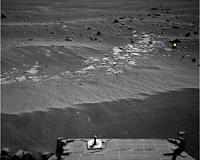 |
Pasadena CA (JPL) Mar 26, 2010 Weird coatings on rocks beside a young Martian crater remain puzzling after a preliminary look at data from examination of the site by NASA's Opportunity rover. The rover spent six weeks investigating the crater called "Concepcion" before resuming its long journey this month. The crater is about 10 meters (33 feet) in diameter. Dark rays extending from it, as seen from orbit, flagged it in advance as a target of interest because the rays suggest the crater is young. The rocks ejected outward from the impact that dug Concepcion are chunks of the same type of bedrock Opportunity has seen at hundreds of locations since landing in January 2004: soft, sulfate-rich sandstone holding harder peppercorn-size dark spheres like berries in a muffin. The little spheres, rich in iron, gained the nickname "blueberries." "It was clear from the images that Opportunity took on the approach to Concepcion that there was strange stuff on lots of the rocks near the crater," said Steve Squyres of Cornell University, Ithaca, N.Y., principal investigator for Opportunity and its twin rover, Spirit. "There's dark, grayish material coating faces of the rocks and filling fractures in them. At least part of it is composed of blueberries jammed together as close as you could pack them. We've never seen anything like this before." Opportunity used tools on its robotic arm to examine this unusual material on a rock called "Chocolate Hills." In some places, the layer of closely packed spheres lies between thinner, smoother layers. "It looks like a blueberry sandwich," said Matt Golombek, a rover science-team member at NASA's Jet Propulsion Laboratory, Pasadena, Calif. Initial analysis of the coating's composition does not show any obvious component from whatever space rock hit Mars to dig the crater, but that is not a surprise, Golombek said. "The impact is so fast, most of the impactor vaporizes," he said. "Thin films of melt get thrown out, but typically the composition of the melt is the stuff that the impactor hit, rather than the impactor material." The composition Opportunity found for the dark coating material fits at least two hypotheses being evaluated, and possibly others. One is that the material resulted from partial melting of blueberry-containing sandstone from the energy of the impact. Another is that it formed from filling of fractures in this type of rock before the impact occurred. "It's possible that when you melt this rock, the sandstone melts before the blueberries do, leaving intact blueberries as part of a melt layer," Squyres said. "As an alternative, we know that this type of rock has fractures and that the sandstone can dissolve. Long ago, water flowing through fractures could have dissolved the sandstone and liberated blueberries that fell down into the fracture and packed together. "In this hypothesis, the impact that excavated the crater did not play a role in forming this material, but split rocks along fractures so the material is exposed on the exterior like a coating." Golombek said, "One consideration that jumps out is that we've been driving around this part of Mars for six years and never seen this stuff before, then we get to this young crater and it's coating rocks all around the crater. Sure looks like there's a connection, but it could just be a coincidence." The observation that the rocks thrown from the crater have not yet eroded away much is evidence that the crater is young, confirming the suggestion from the dark rays. Squyres said, "We're not ready to attach a number to it, but this is really young. It is the youngest crater we've ever seen with Opportunity and probably the youngest either rover has seen." One question Opportunity's visit did answer was about the dark rays: "We wondered before getting to Concepcion why the rays are dark," Golombek said. "We found out that the rays are areas with blocks of light-toned sandstone ejected from the crater. They look dark from orbit because of the shadows that the blocks are casting when the orbital images are taken in mid-afternoon." Since departing Concepcion on March 9, Opportunity has driven 614 meters (2,014 feet) farther along the route to its long-term destination at Endeavour Crater, about 19 kilometers (12 miles) in diameter and still at a drive distance of more than 12 kilometers (7 miles). Squyres said, "We're on the road again. We have a healthy rover and we have enough power for substantial drives. We want to get to Endeavour with a healthy rover. It takes a compelling target for us to stop and study. And Concepcion was a compelling target."
Share This Article With Planet Earth
Related Links View all related images Mars rovers Mars News and Information at MarsDaily.com Lunar Dreams and more
 NASA Mars Rover Getting Smarter As It Gets Older
NASA Mars Rover Getting Smarter As It Gets OlderPasadena CA (JPL) Mar 24, 2010 NASA's Mars Exploration Rover Opportunity, now in its seventh year on Mars, has a new capability to make its own choices about whether to make additional observations of rocks that it spots on arrival at a new location. Software uploaded this winter is the latest example of NASA taking advantage of the twin Mars rovers' unanticipated longevity for real Martian test drives of advances made ... read more |
|
| The content herein, unless otherwise known to be public domain, are Copyright 1995-2010 - SpaceDaily. AFP and UPI Wire Stories are copyright Agence France-Presse and United Press International. ESA Portal Reports are copyright European Space Agency. All NASA sourced material is public domain. Additional copyrights may apply in whole or part to other bona fide parties. Advertising does not imply endorsement,agreement or approval of any opinions, statements or information provided by SpaceDaily on any Web page published or hosted by SpaceDaily. Privacy Statement |